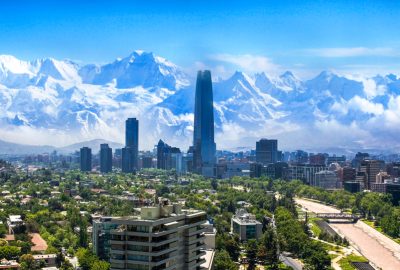I can’t wrap my mind around the enormous scale of the Spanish conquest over South America. All the logistics, resources, manpower and most of all: the violence. Yeah, that one stuck around. A lot of blood was shed for this continent to become what it is today. Chile, with its capital city Santiago, was no different. Maybe a tiny little bit. Conquistadors peacefully approached the indigenous community who offered a piece of land as a gesture of goodwill. Construction began and everything was looking just peachy.
The shit hit the fan when the bulk of Spanish forces left and the locals decided to reclaim their land. It wasn’t pretty. Let’s just say it ended with native heads on pikes. The feud went quiet for a while, but then the Spaniards got hit by a period of hunger and earthquakes. They supposedly ate “whatever they could find” and worn animal skins for clothes. Sounds like Lord of the Flies; savage stuff. Then fast forward hundreds of years of wars, floods, earthquakes, dictatorships, and smallpox. You’d think that all the hardship would break any other nation. At this point, I think the natives who knew this land was cursed just pranked them. However, the Chileans endured and Santiago somehow grew among all that disaster. The capital grew to almost 6 million inhabitants, which equals to around 40% of Chiles population.

Against the backdrop of the magnificent Andes stands the tallest skyscraper in Latin America: Gran Torre Santiago
The weird thing is that it doesn’t look that crowded during tourist season. Probably because it’s so hot and dry during summers. People usually go out during the evenings when it’s…Chile (HA-HA). You’ll notice those huge hills both within and outside Santiago. It resembles Los Angeles in a way. San Cristobal Hill stands in the middle of the city, surrounded by a beautiful urban park. Hiking to the top takes around an hour, but it’s no easy task. It’s customary to reward yourself with a serving of Mote con Huesillos when you reach the peak. It’s a drink made of peach syrup and chunks of wheat. Sounds weird, but it’s really good. Sip on your sugary beverage and contemplate while relaxing next to the statue of the Virgin Mary. John Paul II himself made the trip to pray at this place. San Cristobal can be a demanding climb. Try Santa Lucia for a more pleasant experience. This is where the city’s foundation stone was laid. It’s a beautiful place with various sculptures, fountains and stone benches. I can’t think of a better spot to relax on a hot day. This is also where the heads-on-pikes incident happened.
All the other historical sites are conveniently located around Plaza de Armas. Sounds familiar? Every Hispanic city has a Plaza de Armas. It’s the main square, the first part of Santiago’s urban planning hundreds of years ago. Museo Historico Nacional houses artifacts from Chilean history and covers the pre-Colombian era until modern times. Edificio del Correo Central stands right next to it. It’s the most stunning post office I’ve ever seen. I can only imagine how busy it used to be: these huge wooden desks, and the rhythmic sound of rubber stamps. National Post is a bit of a dying service in the modern era. I wouldn’t be surprised if they turned it into a museum. The building itself is so beautiful they gave it a national monument status. Last, but not the least you will notice the impressive Santiago Metropolitan Cathedral. There’s an on-going theme with South American cathedrals getting destroyed by earthquakes. This one was rebuilt three times over the years. It’s a larger than life monument, filled with gold and marble sculptures. All these cathedrals are ridiculous. I have no idea how people are supposed to focus on humble prayer within these walls.

The atmospheric Plaza de Arma; the central point of Santiago, here you can see al Pueblo Indigena monument, dedicated to the Indians exterminated by the conquerors
Santiago is at its best during the evenings. Visit the Central Market for some sustenance before you sample the nightlife. Mercado Central is probably what you would expect; something between a food court and a market. The local seafood is great. The Pacific is two hours away from Santiago after all. The actual party scene is all over the place. Having said that, I’d stay away from the main streets. The best fun in Santiago is in exploring all those narrow backstreets. Barrio Bellavista is where most people go out for drinks. You’ll find everything there from posh wine spots and gay bars to dirty pubs and sidewalk cafes. Barrio Brasil is more of a genuine old-school place for mature people. There are wineries outside of Santiago if you want to take the trip. Chilean wine has gotten quite a large fan base all over the world meanwhile. I’m not a wine person, but I believe people when they say it’s good.



No one commented yet. Be the first.